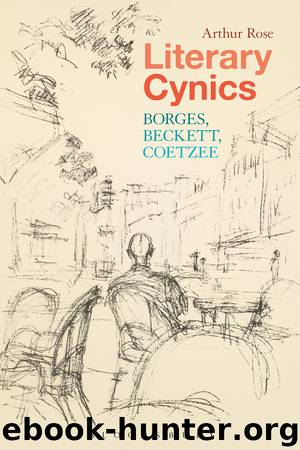Literary Cynics by Literary Cynics

Author:Literary Cynics
Language: eng
Format: epub
Published: 2017-03-18T16:00:00+00:00
The Listener’s knocks form an interesting pattern of interventions, since each time the Listener knocks, the Reader returns to the line he has just read, reads it again and pauses, waiting for a knock to signal that he can continue. The Listener makes seven such interventions in total. The first, quoted earlier, halts the Reader at the first line of the play, which signals that, if the play has just begun, it is nevertheless also about to end. The second occurs when the Reader reads, ‘Then turn and his slow steps retrace’ (SB3 474), a line that emphasizes the circularity of the action, through habit, but also makes this emphasis ironic, since the Listener interrupts the narrative. The third recalls my interest in image and voice, since the Reader describes seeing the dear face and hearing the unspoken words of the departed to emphasize the advice, ignored, that the character stay where they ‘were so long alone together’ (SB3 474). The Listener’s fourth interruption is not a knock, which distinguishes it from the other six interventions and marks it as the climax of the piece; it is a gesture that ‘checks’ the Reader’s return to earlier pages (page forty paragraph four), where the symptoms of the character’s habitual ‘terror of the night’ are described (SB3 475). The fifth and sixth interruptions occur when the Reader’s narrative repeats lines that precipitated the first and third interruptions. The final interruption causes the Reader to repeat the final phrase of the play: ‘Nothing is left to tell’ (SB3 476). This symmetry provides us with an interesting fugue-like series of repetitions and variations in counterpoint to the narrative continuity of the tale the Reader tells.49 By focusing on the Listener’s interruptions, rather than the Reader’s narrative, a pattern emerges in which an emphasis on narrative continuity is displaced by concentrating on rhythm and timing. Moreover, it shows how Beckett’s antinomies interrupt narratives, even his own narrative, to destabilize its apparent homogeneity. It breaks open its closed system. If the play-as-text uses the image and the voice to undermine closed structures, it still remains unclear what this means in the context of its actual performance to an international audience of Beckett scholars.
Ohio Impromptu was written at the request of Gontarski. Brater, in Beyond Minimalism, provides further context. He reports that Beckett told a surprised Alan Schneider that the original audience gathered in Columbus would laugh when the curtain went up on Ohio Impromptu. He was right.50 Insofar as it is possible for a playwright to ‘script’ an audience, Ohio Impromptu provided the perfect opportunity. Gontarski, in his review of Ohio Impromptu, noted that the play was created for the 450 or so literary critics in attendance. ‘Beckett is certainly meditating in Ohio Impromptu on the play within the occasion, the artist speaking to his critics.’51 Beckett could predict that the audience would laugh because the image of two mirror selves sitting across the table from each other contained enough cues to other plays in which
Download
This site does not store any files on its server. We only index and link to content provided by other sites. Please contact the content providers to delete copyright contents if any and email us, we'll remove relevant links or contents immediately.
4 - Harry Potter and the Goblet of Fire by J.K. Rowling(2686)
2010-The City & the City by China Miéville(1960)
Wall and Piece by Banksy(1800)
Thank You for Being Late by Thomas L. Friedman(1756)
The Old Farmer's Almanac 2020 by Old Farmer’s Almanac(1706)
The Mirror and the Light by Hilary Mantel(1655)
Journey to the Abyss by Harry Kessler(1620)
The Andy Warhol Diaries by Andy Warhol(1578)
Tolkien, J. R. R. - The Fellowship of the Ring by Tolkien J. R. R(1520)
Life on Earth by David Attenborough(1472)
Art Nouveau by Carol Belanger Grafton(1410)
The Museum Of Innocence by Orhan Pamuk(1389)
Harry Potter - A History of Magic by British Library(1382)
The Business of Being an Artist by Daniel Grant(1353)
The Future Is Japanese by(1302)
Frida by Hayden Herrera(1295)
Impeach by Neal Katyal(1263)
A History of Japanese Art by Noritake Tsuda(1208)
1215 by Danny Danziger(1184)
